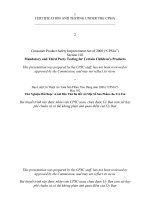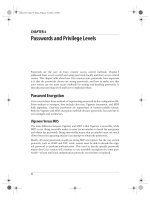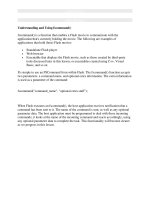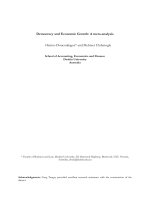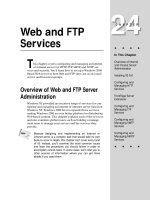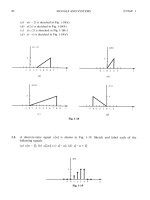Tài liệu COMPLEMENTARY AND ALTERNATIVE MEDICINE ETHICS, THE PATIENT, AND THE PHYSICIAN pdf
Bạn đang xem bản rút gọn của tài liệu. Xem và tải ngay bản đầy đủ của tài liệu tại đây (526.3 KB, 260 trang )
Complementary
and Alternative
Medicine
B I O M E D I C A L E T H I C S R E V I E W S
Ethics, the Patient,
and the Physician
EDITED
BY
Lois Snyder
Complementary
and Alternative Medicine
BIOMEDICAL ETHICS REVIEWS
Edited by Lois Snyder
Complementary and Alternative Medicine:
Ethics, the Patient, and the
Physician • 2007
Edited by James M. Humber and Robert F. Almeder
Stem Cell Research • 2004
Care of the Aged • 2003
Mental Illness and Public Health Care • 2002
Privacy and Health Care • 2001
Is There a Duty to Die? • 2000
Human Cloning • 1999
Alternative Medicine and Ethics • 1998
What Is Disease? • 1997
Reproduction, Technology, and Rights • 1996
Allocating Health Care Resources • 1995
Physician-Assisted Death • 1994
Bioethics and the Military • 1992
Bioethics and the Fetus • 1991
Biomedical Ethics Reviews • 1990
Biomedical Ethics Reviews • 1989
Aids and Ethics • 1988
Biomedical Ethics Reviews • 1987
Quantitative Risk Assessment:
The Practitioner’s Viewpoint
• 1986
Biomedical Ethics Reviews • 1985
Biomedical Ethics Reviews • 1984
Biomedical Ethics Reviews • 1983
BIOMEDICAL
ETHICS
REVIEWS
C
OMPLEMENTARY
AND
A
LTERNATIVE
M
EDICINE
E
THICS
,
THE
P
ATIENT
,
AND
THE
P
HYSICIAN
Edited by
Lois Snyder
Philadelphia, PA
© 2007 by Humana Press Inc.
999 Riverview Drive, Suite 208
Totowa, NJ 07512
humanapress.com
For additional copies, pricing for bulk purchases, and/or information about other
Humana titles, contact Humana at the above address or at any of the following
numbers: Tel.: 973-256-1699; Fax: 973-256-8341; E-mail: , or
visit our Website: humanapress.com
All rights in any form whatsoever reserved.
No part of this book may be reproduced, stored in a retrieval system, or transmitted in any form
or by any means (electronic, mechanical, photocopying, microfilming, recording, or other-
wise) without written permission from the publisher.
All authored papers, comments, opinions, conclusions, or recommendations are those of
the author(s) and do not necessarily reflect the views of the publisher.
This publication is printed on acid-free paper. ∞
ANSI Z39.48-1984 (American National Standards Institute) Permanence of Paper for
Printed Library Materials.
Cover design by Patricia F. Cleary
Production Editor: Christina Thomas
Photocopy Authorization Policy:
Authorization to photocopy items for internal or personal use, or the internal or personal use
of specific clients, is granted by Humana Press Inc., provided that the base fee of US $30.00
per copy, is paid directly to the Copyright Clearance Center at 222 Rosewood Drive,
Danvers, MA 01923. For those organizations that have been granted a photocopy license
from the CCC, a separate system of payment has been arranged and is acceptable to
Humana Press Inc. The fee code for users of the Transactional Reporting Service is: [978-
1-58829-584-2 • 1-58829-584-2/07 $30.00].
e-ISBN 1-59745-381-1
Printed in the United States of America. 10 9 8 7 6 5 4 3 2 1
Library of Congress Cataloging-in-Publication Data
Complementary and alternative medicine : ethics, the patient, and the physician / edited by
Lois Snyder.
p. ; cm. (Biomedical ethics reviews ; 2007)
Includes bibliographical references and index.
ISBN-13: 978-1-58829-584-2
ISBN-10: 1-58829-584-2 (alk. paper)
1. Medical ethics. 2. Physicians and patients Moral and ethical aspects. I. Snyder, Lois,
1961- II. Series.
[DNLM: 1. Complementary Therapies ethics. 2. Physician-Patient Relations ethics.
W1 BI615 2007 / WB 890 C73666 2007]
R724.C662 2007
174.2 dc22
2006018114
v
To my daughter Hannah
Contents
ix Preface
xiii Contributors
1 Chapter 1: A Context for Thinking About Complementary
and Alternative Medicine and Ethics
Lois Snyder
7 Chapter 2: Complementary and Alternative Medicine:
History, Definitions, and What Is It Today?
Richard J. Carroll
45 Chapter 3: Complementary and Alternative Medicine:
The Physician’s Ethical Obligations
Wayne Vaught
77
Chapter 4: Advising Patients About Complementary
and Alternative Medicine
Arti Prasad and Mariebeth B. Velásquez
121 Chapter 5: Patient and Medical Education on Complementary
and Alternative Medicine: Sorting It Out
Catherine Leffler
167 Chapter 6: Legal and Risk Management Issues
in Complementary and Alternative Medicine
Michael H. Cohen
201 Chapter 7: Whose Evidence, Which Methods? Ethical
Challenges in Complementary and Alternative
Medicine Research
Jon Tilburt
231 Index
vii
ix
Preface
With this edition of Biomedical Ethics Reviews we com-
mence a somewhat new focus for the series. Building on its solid
tradition of exploring and debating pressing bioethical issues of
the day, this series will now also examine the real-life implica-
tions of these issues for patients and the health care system in
which care is delivered. With each topic, attention will be fo-
cused not only on the theoretical and policy aspects of ethical
dilemmas, but also on the clinical dimensions of these challenges,
and effects on the patient–physician relationship.
A fitting early topic for Biomedical Ethics Reviews in the
21st century is complementary and alternative medicine (CAM).
The National Center for Complementary and Alternative Medi-
cine (NCCAM) defines CAM as “a group of diverse medical and
health care systems, practices, and products that are not presently
considered to be part of conventional medicine.” A telling defini-
tion, for what it actually seems to define is what CAM is not. We
will probably be coming to terms with CAM and its value in
promoting the health of the mind, body, and spirit, its approaches
to the causes of illness, and to the restoration of the balance that
is health, for some time. Chapters 1 and 2 in Complementary and
Alternative Medicine: Ethics, the Patient, and the Physician
provide a context for thinking about CAM and introduce the
history and definitions of CAM.
Another aspect of how we define CAM focuses on ques-
tions yet to be resolved through scientific studies about whether
such therapies are safe and effective against the illnesses and con-
ditions for which they are used. An editorial in one of medicine’s
leading journals, JAMA (1998;280:1618-1619), said, “There is
no alternative medicine. There is only scientifically proven, evi-
dence-based medicine supported by solid data or unproven medi-
x Preface
cine, for which scientific evidence is lacking.” Yet, as is raised in
Chapters 3, 4, and 7 on CAM and the physician’s ethical obliga-
tions; communicating with and advising patients about CAM; and
CAM research, respectively, we do not necessarily have that sci-
entific evidence for many so-called conventional therapies. How
to review CAM under the scientific method is further explored in
Chapter 7. And, of course, what is considered CAM will continue
to be a moving target, as evidence of safety and effectiveness
moves CAM therapies into conventional medical practice.
In the meantime, it is estimated that approximately 42% of
Americans spent $27 billion out of pocket on CAM therapies in
1997. This, according to a 2005 report of the Institute of
Medicine (IOM) of the National Academy of Sciences, Comple-
mentary and Alternative Medicine in the United States. The IOM
found a huge increase in CAM use over the period 1990 through
1997, with the total number of visits to CAM practitioners rising
47%, to 629 million visits in 1997. That surpasses total visits to
primary care physicians for that year at 386 million. Most people
do not tell their physicians about their CAM use, with implica-
tions for the patient-physician relationship and the ethics obliga-
tions of physicians (Chapter 3), advising patients (Chapter 4),
patient education (Chapter 5), and liability concerns (Chapter 6).
CAM therapies are extremely popular with baby boomers,
who take a very active interest in their health and health care and
presumably will do so even more as they age. And as they age,
the boomers 65 and older are expected to grow to 20% of Ameri-
cans (more than 66 million people) by 2030.
NCCAM, on the other hand, is quite young, only established
by Congress in 1998. Its mission is to explore complementary
and alternative healing practices in the context of rigorous
science, train CAM researchers, and disseminate evidence-based
information to the public and health care professionals. Its 2004
fiscal year budget for this ambitious agenda was $117,752,000.
So, with big issues and big money at stake, how are patients,
physicians, the health care system and policymakers handling the
explosion in CAM interest and use? What implications does it
have for traditional patient-physician relationships? What are the
physician’s ethical obligations in this area? These topics and more
are examined in Complementary and Alternative Medicine:
Ethics, the Patient, and the Physician.
Lois Snyder, JD
Preface xi
xiii
Editor
Lois Snyder, JD is director of the Center for Ethics and
Professionalism at the American College of Physicians, the
national professional society of doctors of internal medicine and
the subspecialties of internal medicine. She has also been adjunct
assistant professor of bioethics and fellow at the University of
Pennsylvania Center for Bioethics. She joined the college in 1987
after serving as a health care consultant on medical malpractice,
risk management, and bioethics issues for hospitals. Ms. Snyder
received her BA in health planning and policy from the University
of Pennsylvania and her law degree from the evening division of
the Temple University School of Law. She is a frequent writer
and speaker on health care policy, bioethical, and medicolegal
issues. She has edited a number of books.
Contributors
Richard J. Carroll, MD, ScM, FACC is a practicing cardiologist.
He received his undergraduate and medical degrees from the
University of Illinois. He is board certified in both internal
medicine and cardiovascular disease, having completed both his
residency and fellowship at Loyola University, Maywood, IL. He
subsequently received his master’s degree in health policy and
management from the Johns Hopkins School of Hygiene and
Public Health, as well as a certificate from the Advanced Training
Program in Health Care Delivery Improvement at Intermountain
Health Care.
Michael H. Cohen, JD, MBA is an attorney in private practice who
publishes the Complementary and Alternative Medicine Law
Blog (www.camlawblog.com). He is an assistant professor of
medicine at Harvard Medical School and director of legal
programs at the Harvard Medical School Osher Institute and
Division for Research and Education in Complementary and
Alternative Medical Therapies.
Catherine Leffler, JD is a senior associate in the Center for Ethics
and Professionalism at the American College of Physicians where
she works in policy development and implementation in the areas
of bioethics, medical professionalism, and human rights. She
received her law degree, with a concentration in health law, from
the Widener University School of Law and her undergraduate
degree from the University of Maryland.
Arti Prasad, MD is an associate professor of internal medicine
and the founding chief of the Section of Integrative Medicine
(SIM) at the University of New Mexico’s (UNM) Health Science
Center. She grew up in India and has a lifetime of experience
with natural and ayurvedic medicine. In November 2003, she
completed an associate fellowship at the Program in Integrative
Medicine at the University of Arizona, Tucson under the direction
of Dr. Andrew Weil. Dr. Prasad is involved in clinical practice,
research, teaching, faculty development, and national continuing
medical education and community education. In addition to her
duties as the chief of SIM, she serves as the director of Integrative
Cancer Programs at the UNM Cancer Research and Treatment
Center.
Lois Snyder, JD is director of the Center for Ethics and
Professionalism at the American College of Physicians, the
national professional society of doctors of internal medicine and
the subspecialties of internal medicine. She has also been adjunct
assistant professor of bioethics and fellow at the University of
Pennsylvania Center for Bioethics. She joined the college in 1987
after serving as a health care consultant on medical malpractice,
risk management, and bioethics issues for hospitals. Ms. Snyder
received her BA in health planning and policy from the University
of Pennsylvania and her law degree from the evening division of
the Temple University School of Law. She is a frequent writer
xiv Contributors
and speaker on health care policy, bioethical, and medicolegal
issues. She has edited a number of books.
Jon Tilburt, MD, MPH received his medical degree from
Vanderbilt University and trained in internal medicine at the
University of Michigan. From 2002 to 2005 he completed both
the Greenwall Fellowship in Ethics and Health Policy as well as a
general internal medicine research fellowship at Johns Hopkins
(where he was also a trainee in the Johns Hopkins Com-
plementary and Alternative Medicine Center). In the Fall of 2005
he took a position as a staff scientist in the Department of Clinical
Bioethics at the National Institutes of Health where he devotes
his time to studying social and ethical aspects of complementary
and alternative medicine with the support of the National Center
for Complementary and Alternative Medicine.
Mariebeth B. Velasquez, BS is a medical student at the
University of New Mexico (UNM) School of Medicine. She
graduated from the University of Washington with a bachelor’s
degree in psychology. She first became interested in com-
plementary and alternative medicine while participating on a
research team at the Fred Hutchinson Cancer Research Center,
which conducted an exercise-intervention study as part of the
Breast Cancer Prevention Research Programs, within the Division
of Public Health Sciences. She serves on the New Mexico State
Advisory Council for Protection and Advocacy Systems for
Individuals with Mental Illness, and is an Advocacy Officer
(UNM Chapter) of the American Medical Student Association.
Contributors xv
CAM and Ethics 1
1
From:
Biomedical Ethics Reviews: Complementary and Alternative
Medicine: Ethics, the Patient, and the Physician
Edited by: L. Snyder © Humana Press Inc., Totowa, NJ
1
A Context for Thinking About
Complementary and Alternative
Medicine and Ethics
Lois Snyder, JD
On treating an earache…
2000
BC Here—eat this root.
1000 AD That root is heathen. Here—say this prayer.
1850 AD That prayer is superstition. Here—drink this potion.
1940 AD That potion is snake oil. Here—take this pill.
1985 AD That pill is ineffective. Here—take this antibiotic.
2000 AD That antibiotic is unnecessary. Here—eat this root.
—A Short History of Medicine (author unknown)
Have we come full circle in the evolution of medicine? The
dictionary defines the term full circle as “back to one’s starting
point,” so the answer is probably no. Complementary and alter-
native medicine (CAM) is changing conventional medicine, and
conventional medicine is changing CAM practices. Clearly, how-
2 Snyder
ever, with the growing popularity of CAM today, patients and the
public want something more or something different than conven-
tional medicine can, in many circumstances, provide.
CAM is many things to many people—from acupuncture to
dietary supplements to homeopathy to massage; some are ancient
practices with rich history, theory, and philosophy behind them,
some are more recent. One of the issues with which we grapple in
this volume is how to define CAM. The use of chiropractic
therapy to treat back pain raises different issues than using chiro-
practic therapy to treat cancer, and this further complicates mat-
ters. Whatever you include in the definition, however, CAM is
growing. In general, patients are said to find CAM in keeping
with their values and beliefs, its popularity not necessarily related
to dissatisfaction with conventional medicine. As such, it seems to
be most often used as a complement to conventional medicine.
Patients value both approaches (1).
Some patients may find CAM useful when conventional
treatment is ineffective; some may value its holistic approach and
unique aspects of the patient–practitioner relationship in CAM;
some may find it empowering, especially its self-care aspects,
such as diet and supplements and efforts at prevention and health
promotion. Clearly, the potential for placebo effects in CAM
practice has value to patients and needs more study. CAM practi-
tioners have been said to be “more optimistic and positive” than
conventional health care providers (who, in fairness, have among
other ethical duties a responsibility to honestly deliver bad news),
and “healing encounters” with CAM practitioners may enhance
this effect (2).
Healing encounter is not a term one finds associ-
ated with today’s short physician office visit. But, it may be that
conventional medicine is “less optimistic and more realistically
accepts the limitations and finitude of the human condition” (3).
Some patients may use CAM as a low-cost alternative to
conventional medicine. A recent study found that individuals
who delayed or deferred conventional care because of cost were
CAM and Ethics 3
also more likely to have used CAM therapies, leading the authors
to conclude CAM use may also reflect the increasing costs of
conventional care, problems in access to that care, and a search
for lower cost approaches (4). The authors, however, urged cau-
tion in the interpretation of their results.
Patient and public interest is high in this area, but so is the
skepticism with which conventional medicine has viewed CAM.
CAM approaches are just starting to emerge into mainstream
medical practice, as is a body of research and effectiveness evi-
dence on CAM therapies (5). A recent editorial by two distin-
guished physicians suggested that the research agenda for CAM
posed many questions but for doctors, “the most compelling ques-
tion is which treatments work and which do not” (5). Similarly, a
recent newspaper article described CAM research under the head-
line, “What Really Works?” (6).
“What works” viewed from the standpoint of scientific
inquiry and what levels of objective evidence support the theory,
however, differs from patient determinations of “what works,”
and needs further exploration. How CAM works, in the context
of patient–provider relationships, trust, particular settings, patient
expectations, communications, decision making, family and social
support, and belief systems may, in fact, be the key factors in the
popularity, value, and effectiveness of CAM. A patient who might
hear from a physician that there is nothing more that can be done
for him or her (equating the end of curative approaches with the
end of care), would not likely hear that in the context of CAM
care.
In addition, patients and physicians often feel rushed and
constrained by time pressures in conventional medicine office
visits, despite evidence that actual visit time has not changed.
This affects patient and clinician satisfaction with care, quality of
care, and can create ethics, communication, and other concerns
in the patient–physician relationship. How to “focus on preserv-
ing the patient–physician relationship, with an emphasis on fos-
4 Snyder
tering trust, maintaining fidelity, demonstrating advocacy, exhib-
iting respect for the patient as a person, and carrying out the indi-
vidual and collective ethical obligations of physicians” is a
challenge in contemporary medicine (7). It may be that CAM
encounters and relationships have offered patients more value and
satisfaction in certain dimensions of care.
One author has said of CAM that, “Against the pride of sci-
ence, it offers humility” (8). He continues that, although CAM
practices are diverse, they share a number of characteristics.
They are:
• Holistic: going beyond biology to see the individual as
part of an integrated system interactive with the environ-
ment and social factors.
• Integrative: healing requires an integration of the spiri-
tual and other forces of life that are out of balance.
• Naturalistic: empowerment of natural life processes is
key.
• Relational: stressing relationships and their role in the
care and healing process, including those between the
patient and practitioner.
• Spiritual (8).
Taken together, these characteristics seem to emphasize a
level of trust and interaction with others and the world that may
not be seen as frequently in medicine. “Nonetheless, these values
are not, for the most part, antagonistic to the values of conven-
tional medicine. They supplement them. They hint not only at the
limitations of current healthcare ethics, but also at how current
norms may be expanded to embrace a more holistic, integrated
model of care” (8).
Use of CAM may also reflect interest in health care
approaches apart from the “hierarchical” world of conventional
medicine (9), where commentators worry that for all of the
emphasis in the Western medical tradition on autonomy and con-
sent, a sense of obedience to physician authority may drive patient
CAM and Ethics 5
actions, not necessarily what is in the patient’s best interest.
“Physicians want to believe their authority resides in their expert
advice, not their social power, and that consent to their inclinations
reflects acknowledgment of that expertise” (9). Do they succeed?
Should they? Do CAM approaches offer an alternative frame-
work and therapeutic relationships and experiences that do bet-
ter? For the healthy patient seeking prevention and health
promotion? For the vulnerable sick patient whose autonomy may
be challenged? For the patient who wants the clinician to make
the treatment decision? A recent study found, for example, that
although most patients want to be offered choices and want to be
asked their opinions about care, 52% wanted their physicians to
make clinical decisions on their behalf (10). Other studies have
shown that, as is discussed more in later chapters, patients fre-
quently do not raise or discuss their CAM use with their physi-
cians.
CAM use raises a host of ethics issues for patients and phy-
sicians, and questions about how the physician and the profes-
sion are to fulfill the traditional obligations of beneficence,
nonmaleficence, justice, and respect for autonomy. Patients and
physicians are not talking much about CAM and when they do,
they may be talking different languages. To date, explorations of
CAM as measured against the science of medicine have outpaced
explorations about CAM, ethics, and the art of medicine. We have
a great deal to learn as well if we are to combine the best of both
worlds. Unless, it is merely the case as Voltaire reflected, that
“The art of medicine consists in amusing the patient while nature
cures the disease.”
REFERENCES
1. Eisenberg DM, Kessler RC, Van Rompay MI, et al. Perceptions
about complementary therapies relative to conventional therapies
among adults who use both: results from a national survey. Ann
Intern Med 2001;135:344–351.
6 Snyder
2. Kaptchuk TJ. The placebo effect in alternative medicine: can the
performance of a healing ritual have clinical significance? Ann
Intern Med 2002;137:817–825.
3. Kaptchuk TJ, Eisenberg DM. The persuasive appeal of alterna-
tive medicine. Ann Intern Med 1998;129:1061–1065.
4. Pagan JA, Pauly MV. Access to conventional medical care and
the use of complementary and alternative medicine. Health Affairs
2005;24:255–262.
5. Bondurant S, Sox HC. Mainstream and alternative medicine: con-
verging paths require common standards. Ann Intern Med 2005;
142:149–150.
6. Payne JW. What really works? Forget hearsay. Here’s how sci-
ence sizes up some therapies. Washington Post, July 12, 2005, p.
HE01.
7. Braddock CH, Snyder, L. The doctor will see you shortly: the
ethical significance of time for the patient–physician relationship.
JGIM 2005;20:1057–1062.
8. Guinn DE. An integrative ethics. Park Ridge Center Second
Opinion #7. Park Ridge, IL: Park Ridge Center, 2001.
9. Cassell EJ. Consent or obedience? Power and authority in medi-
cine. N Eng J Med 2005;352:328–330.
10. Levinson W, Kao A, Kuby A, Thisted RA. Not all patients want
to participate in decision making: A national study of public pref-
erences. JGIM 2005;20:531–535.
History and Definitions of CAM 7
7
From:
Biomedical Ethics Reviews: Complementary and Alternative
Medicine: Ethics, the Patient, and the Physician
Edited by: L. Snyder © Humana Press Inc., Totowa, NJ
2
Complementry and Alternative
Medicine
History, Definitions,
and What Is It Today?
Richard J. Carroll, MD, SCM, FACC
INTRODUCTION
No topic in the health care arena has been the subject of
more heated debate in the last few years, short of access to care
and health care costs, than complementary and alternative medi-
cine (CAM). CAM has been the focus of extensive media atten-
tion, numerous medical articles, books, periodical reviews, as
well as the topic of talk shows and dinner conversations. Many
patients are seeking increasingly more information from their
physicians and other resources about alternatives to conventional,
allopathic medicine.
8 Carroll
Health care practitioners are also demonstrating an increased
level of interest in CAM, not only to better understand its interac-
tion with conventional medicine, but as an additional resource
for both their patients and themselves. Hospitals and health care
systems are struggling to develop guidelines for credentialing
CAM practitioners, as well as opening avenues to accommodate
care practitioners and techniques unique to their current frame-
work of health care. Insurance companies are reevaluating what
services to provide their customers, while out of pocket expendi-
tures for CAM continue to rise. Articles in popular publications
outline how to add CAM practitioners into traditional medical
practices, focusing on issues such as liability, reimbursement, and
supervisory responsibilities in order to include services sought
by many of their patients (1).
CAM has certainly become a permanent part of the health
care culture and landscape as the borders between conventional
medicine and CAM begin to blur. The results are numerous clini-
cal, economic, ethical, legal, and social issues associated with
not only the increased interest in the use of CAM, but a reevalu-
ation of conventional medicine as well.
This chapter briefly reviews some basic definitions of what
has now been labeled CAM, some statistics on its use, why and
for what type of disease entities patients choose CAM, and why
patients are drawn to these approaches; outlines the major types
of CAM used in the United States; provides some brief data on
the effectiveness (or lack of effectiveness) of CAM; as well as
provides some thoughts/insights regarding health care in general
and the role both conventional and CAM will surely play.
DEFINITIONS
For the purposes of this chapter, the term conventional medi-
cine is used when referring to what most readers would consider
contemporary, allopathic medicine. Conventional medicine
